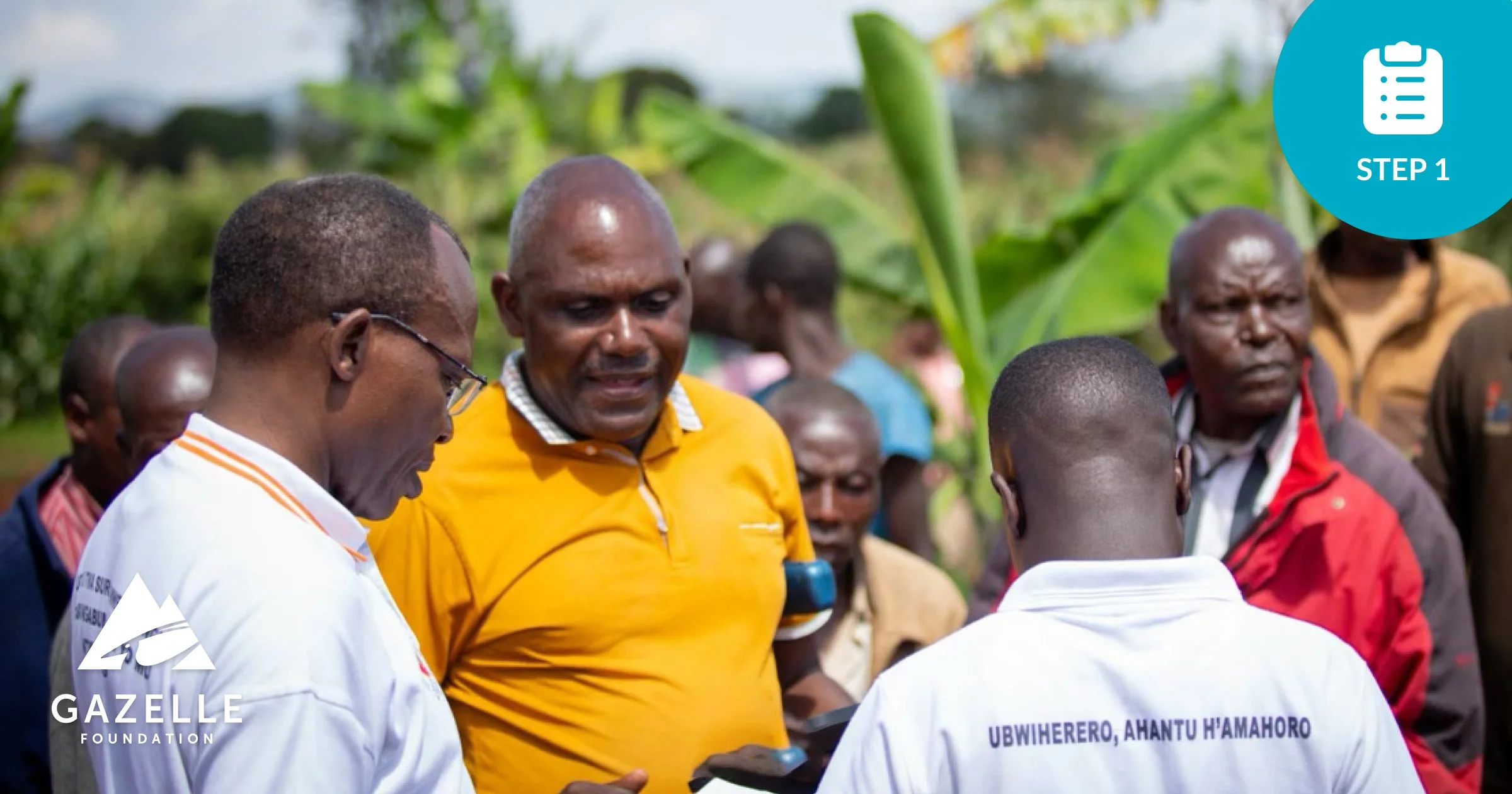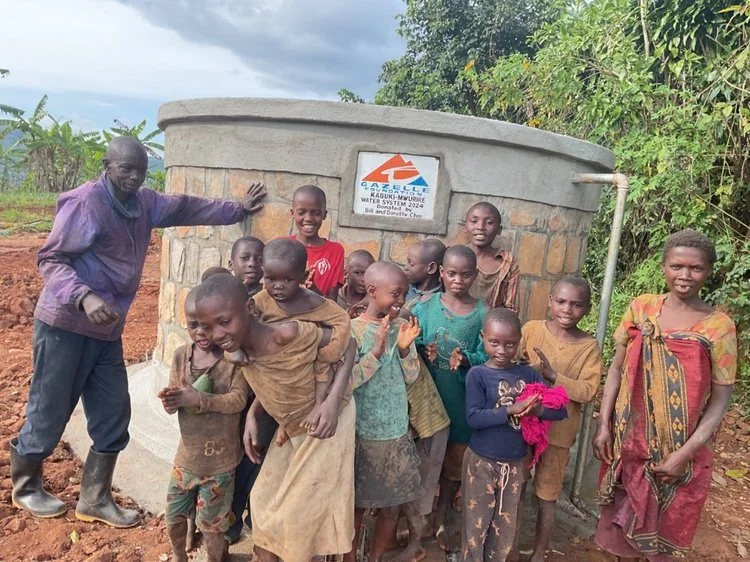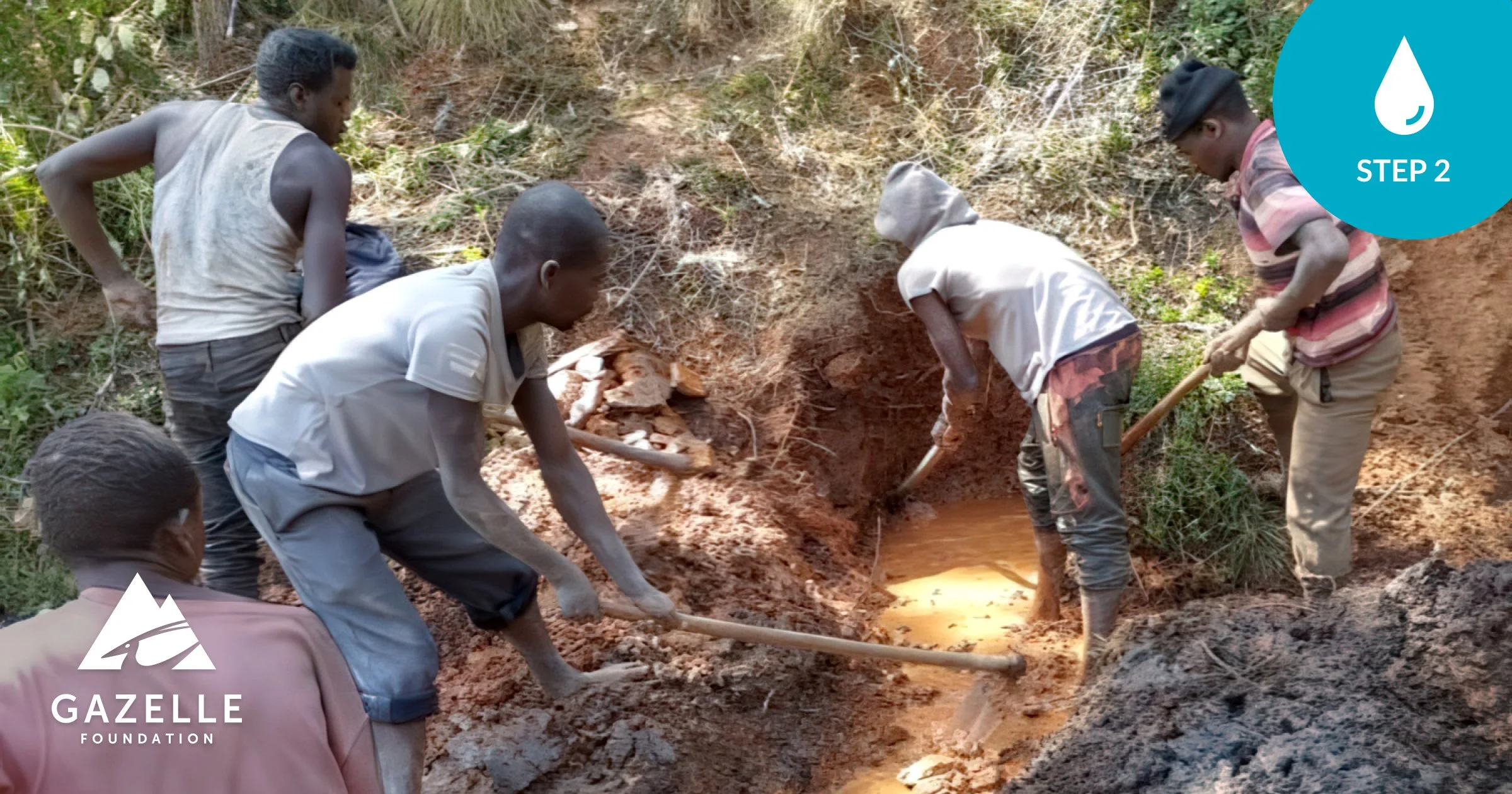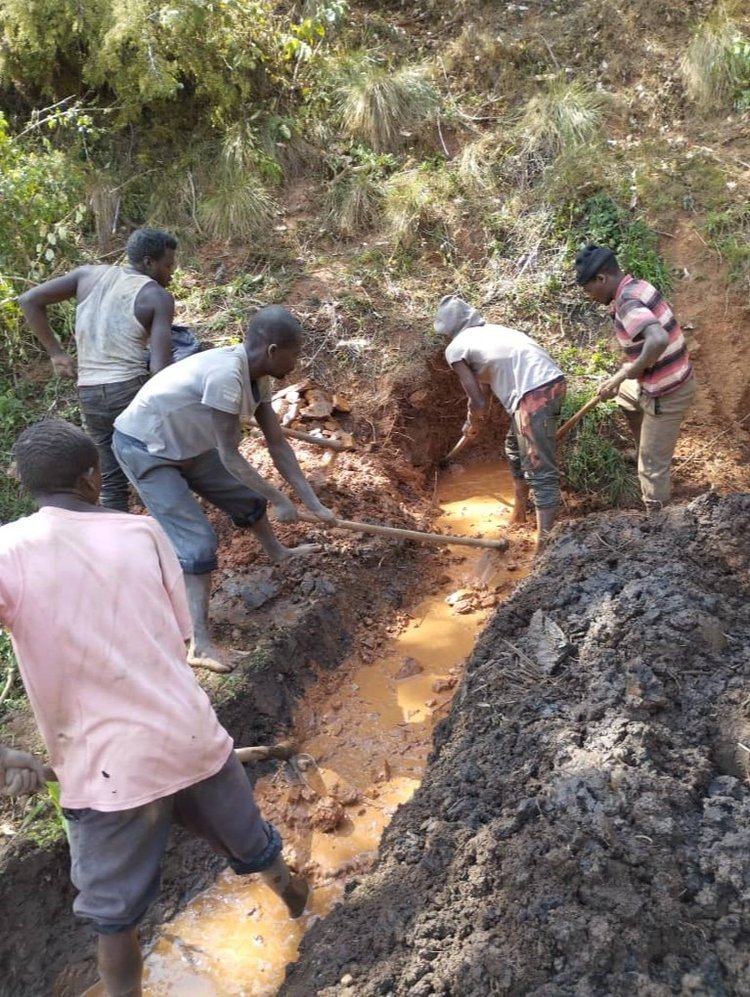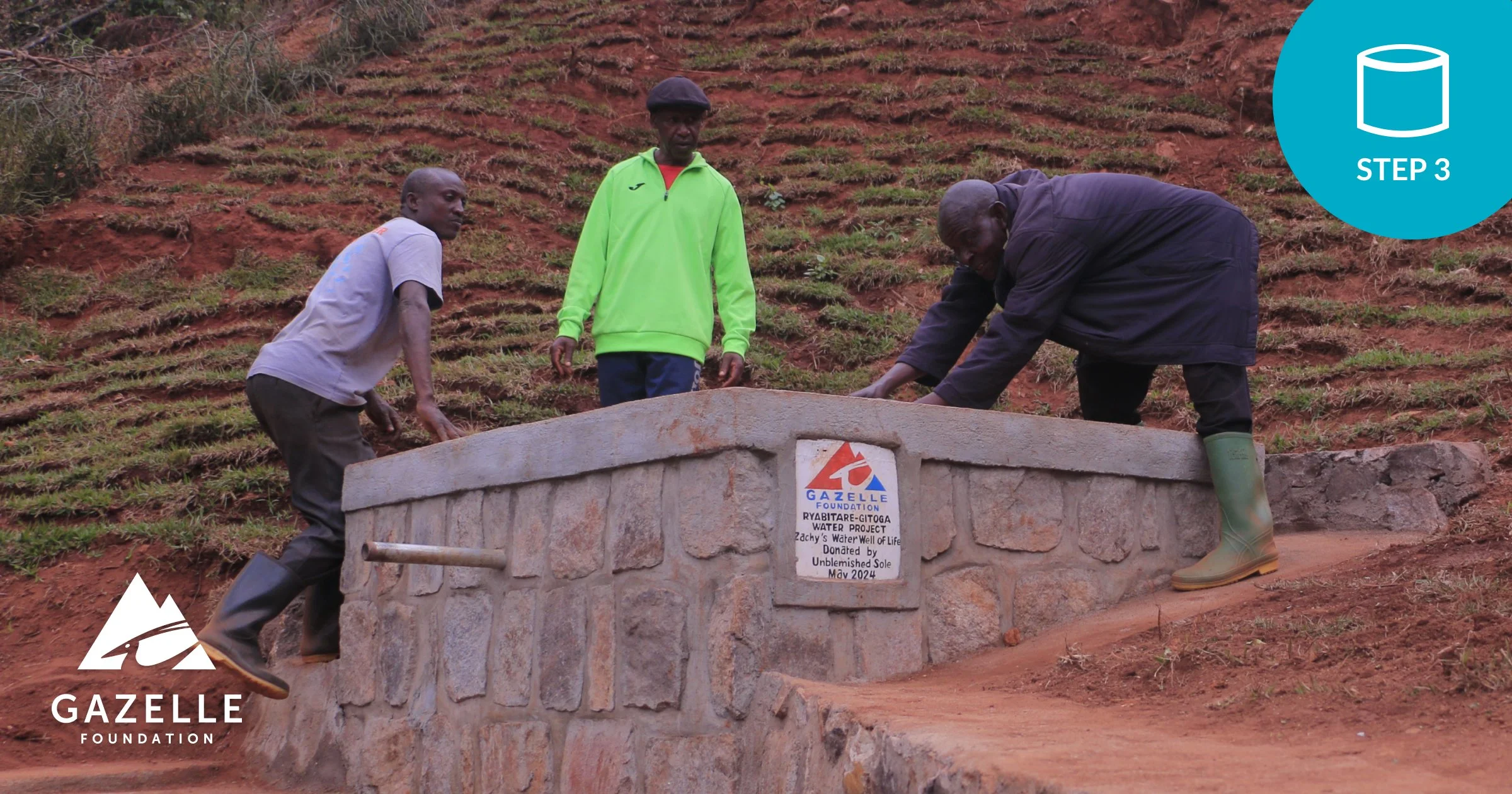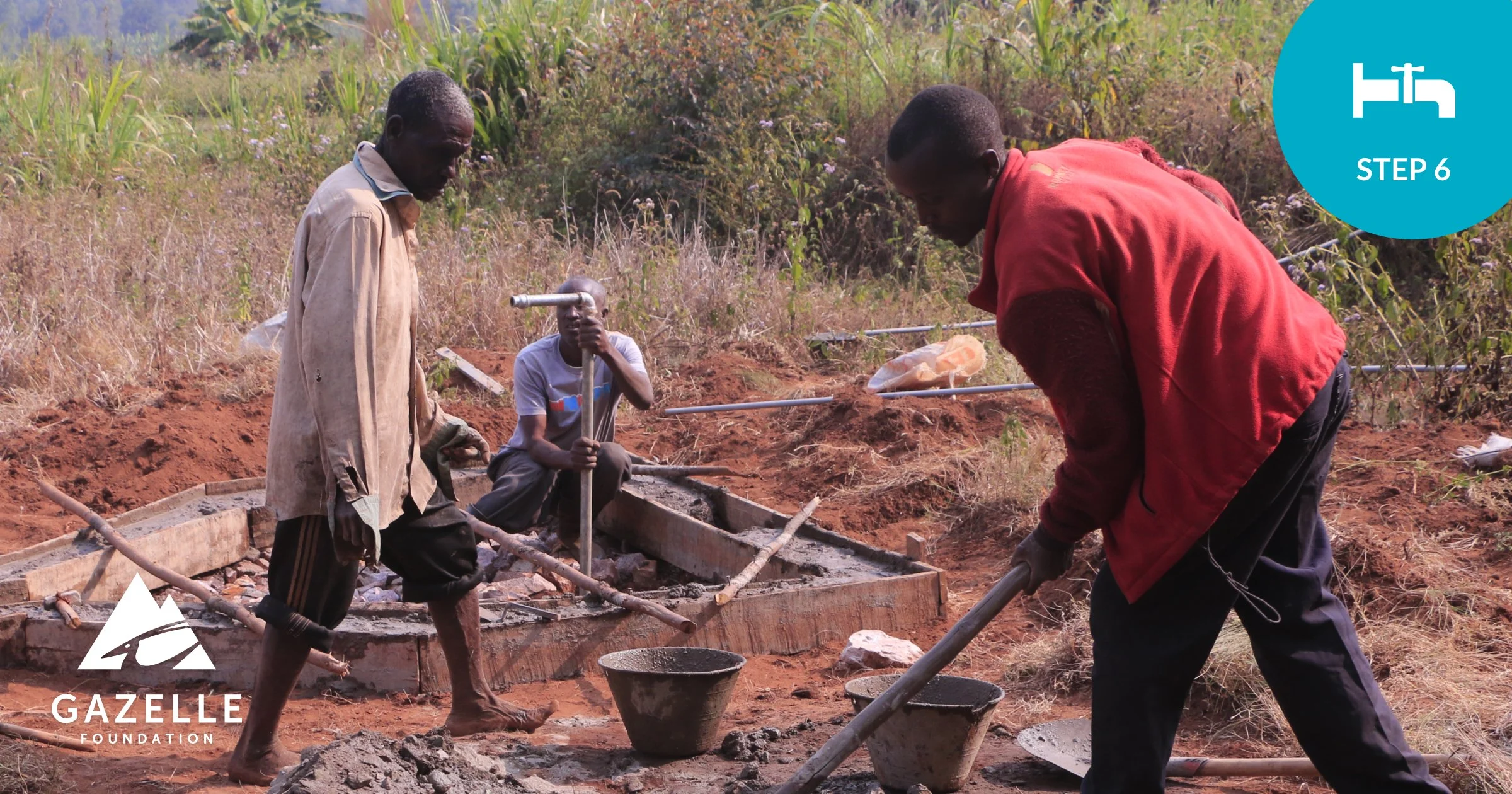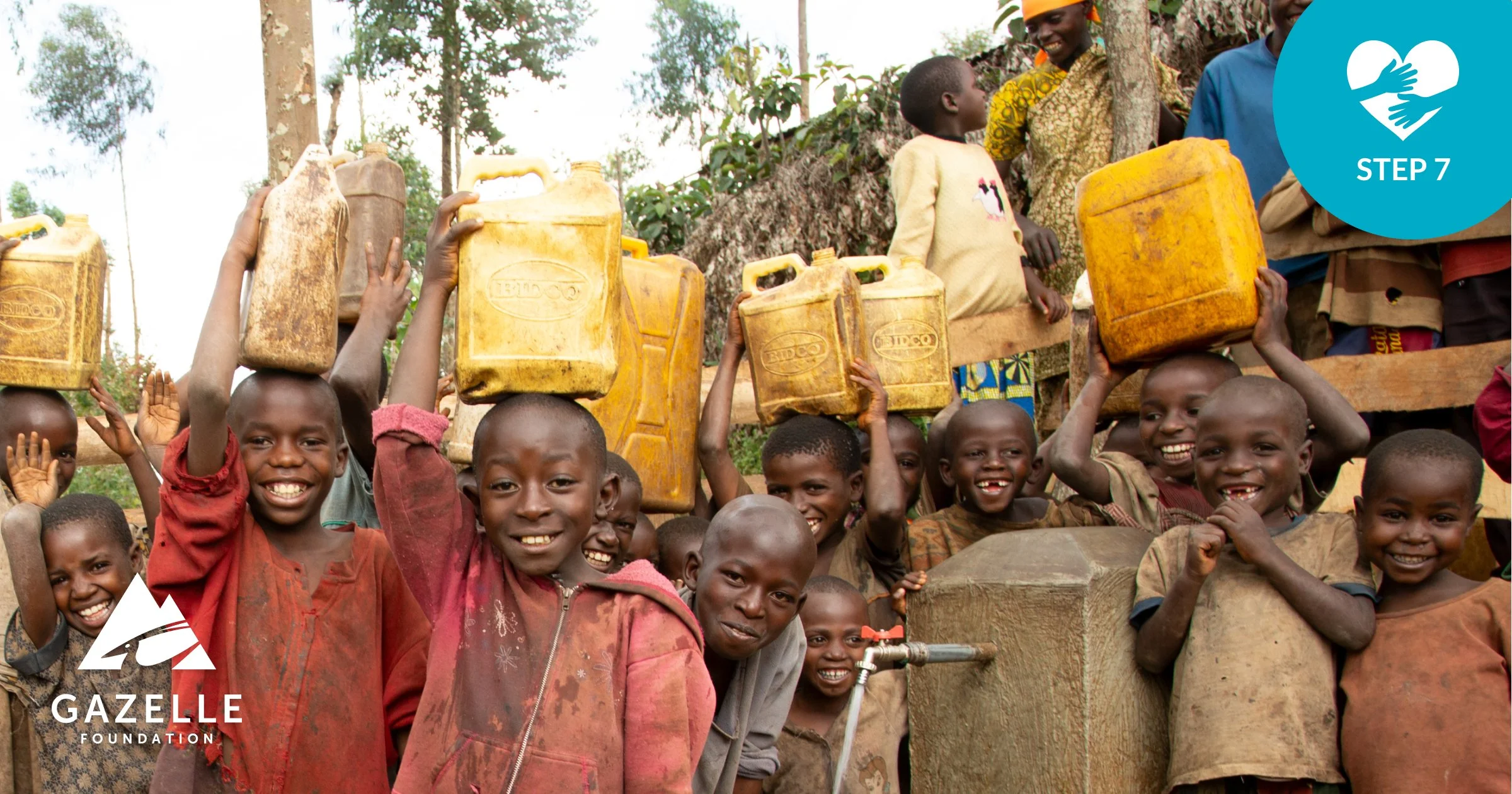Designing and building a water system is no simple task, however our proven process is used again and again because it works. Our process building low-tech, high-impact sustainable water systems in Burundi takes seven steps:
Step 1 | Pre-Construction and Project Kick off
As project manager, Mr. Ndabaniwe’s (in yellow) role encompasses all aspects of implementing the Gazelle Foundation’s mission in Burundi. Part of his work includes hiring and managing the local workers who build the water systems, in an effort to both create jobs within the communities as well as build institutional knowledge of how to maintain and repair the systems, once they are turned over to the community.
Once a specific water system is funded, our team in the United States officially greenlights the project. A contract between Gazelle Foundation and the project manager in Burundi is executed. The contract includes an exact timeline and budget, the scope of work, including specific tasks, materials, and services, schematics, and reporting standards.
Progress payments are made based on the milestones and the pay schedule identified in the contract. The first payment is for construction supplies, labor, and transportation of materials to the job site. A typical water system is 3-1/2 miles long.
There are no big-box warehouse stores like Home Depot or Lowes in Burundi. Construction materials are sourced and purchased locally and in cities like Bujumbura before being transported to the construction site. Purchasing supplies and materials locally, further boosts the community’s economy. When the construction site is not accessible by roadway, workers and residents carry the supplies the final stretch.
How the Project is Managed in Burundi
Our longstanding project manager in Burundi, Jean Bosco Ndabaniwe, oversees every aspect of the project from purchasing supplies to the transportation of materials and tools to the job site to hiring workers, construction, testing, and transfer of ownership of the system to the beneficiary community. He also coordinates with local authorities in Burundi. Learn more about Jean Bosco Ndabaniwe.
How the Project is Managed in the United States
Our team in the United States monitors project milestones, receiving GPS coordinates, receipts, progress updates, and photographs. You can read about each water system we have built and those that are in progress. Pictures and updates are recorded for each water system and can be accessed on our website.
How We Name Water Systems
Each water system is named for the geographic source of the water and the community where the water is used. The water collection chamber and storage tanks are labeled with the name of the water system. Donors who sponsor water systems or parts of water systems have the opportunity to also have their name on the water collection chamber and storage tanks. Contact us to learn more.
The Kabuki-Mwurire water system was donated by Alvin Chee in honor of his parents Bill and Dorothy Chee.
Step 2 | Securing The source of clean water
Water is captured from a hilltop spring source before it can become contaminated. These workers are excavating a water source that will soon fill a water collection chamber.
Burundi's topography, characterized by hills ("collines"), mountains, and springs, presents both challenges and opportunities for engineering water systems. Our water systems use gravity to distribute water and are fed by one or multiple springs.
Excavating and stabilizing the water source: Excavating a trench or pit upslope from the spring's outlet happens first. It’s muddy work to intercept the water source at a depth where it flows freely.
One or multiple springs may feed a water system to engineer enough water flow (liters per second) that will provide as much water as everybody in the community needs.
Step 3 | Build a water collection chamber
The Collection Chamber exterior is constructed with rocks and concrete. It functions as the heart of the water system. The chamber structure includes perforated pipe and gravel, and a spring box to manage flow and prevent contamination from runoff or other sources.
This structure allows for the controlled collection of water and often includes features like an outlet for filtered water and an overflow for excess water.
The water collection chamber filters water before it is distributed to storage tanks and tap stands located throughout the communities it will serve. Gazelle Foundation collection chambers are recognizable by their shape and orange square lid, visible on the schematic plans, too.
Step 4 | Dig Trenches for Pipeline
Trenches to carry buried water distribution pipe will be dug by hand in flat and hilly conditions. Hiring local workers also develops local knowledge for upkeep and maintenance, as the ownership of all water systems are turned over to the community upon completion.
Once the collection chamber is built, clean water is accessible right away. This water pipe will eventually be connected to tap stands that can be turned on and off.
Miles or kilometers of trenches are hand-dug near agricultural fields, pathways, and across terrain.
Our water systems are engineered using two different pipelines:
principal pipeline transports water from the collection chamber to water tanks, and
distribution pipeline transports water from tanks to the tap stands.
Once the collection chamber is built, clean water flows and is available to the community. It’s accessible via pipeline and eventually from tap stands when they are built.
Since 2006, hundreds of miles of trenches for pipeline have been dug. The cumulative number is tracked on Our Impact page.
Step 5 | Construct storage tanks
Storage tanks are built to last. Most tanks we build are either 5m3 or 10m3.
Water tanks hold water, ensuring a steady and reliable supply for various uses for the community in every season. Most tanks we build are either 5m3 or 10m3 by volume, and water systems can have multiple tanks dispersed throughout the community. Each finished water tank has a marker indicating the project’s name and year of construction.
Step 6 | Build water tap Stands
When constructing a tap stand, ensuring proper drainage is crucial to prevent issues like mud pools, erosion, and potential public health risks. Wooden forms pictured show how the plumbing fits into the base infrastructure and direct water away from the tap stand area.
Tap stands are strategically placed to reduce the average walk from 4 miles to a quarter mile. This distance equates to roughly a 400-meter lap around a running track.
Concrete forms and distribution pipes are added before the concrete is mixed and poured. During construction of a water systems, tap stands become operational as the system is built — the entire system does not need to be finished for people to be able to access clean water.
Water is available for free to all people regardless of the person’s tribe or religion.
Step 7 | Transfer Ownership to the COMMUNITY
Children and women do many of the water fetching chores, so having clean water nearby means they can spend more time in school and other pursuits.
After the water system is complete and tested, the community participates in a formal ceremony to officially celebrate the transfer of ownership to the village. Local dignitaries attend, and a formal document is signed (see below) the event can also be full of music and joyous dancing.
Those who worked on the systems use their knowledge to maintain their water systems. This local know-how means every village has the expertise to maintain its water system indefinitely.
Celebration expressing joy for clean water.
The Gazelle Foundation’s co-founder Gilbert Tuhabonye has family ties in Burundi and regularly visits villages that have benefited from these sustainable, gravity-fed water systems. Since our founding in 2006, all the water systems we have constructed in partnership with Burundian communities remain 100% operational.
Kirundi, French, and English are the official languages in Burundi. Kirundi is most common, followed by French as you can see in this written document transferring ownership of the water system to the community.
Young children fetch water. Close access to clean water means they will be able to spend more time in school. Access to clean water is perhaps the single most powerful tool for sparking economic growth that humanity has ever known.
The Impact of Clean Water
Our proven process has resulted in 73 water systems so far serving more than 138,000 individuals. Our unique structure and on-the-ground partnerships help maintain lower-than-average costs to build effective, sustainable water systems. Read more about our impact.
Since 2006, the Gazelle Foundation has been partnering with Burundian communities to spread hope and peace via bringing close access to clean water. Burundians tell us how clean water has affected their day to day lives.
Close access to clean water means boys and girls are able to attend school, everyone’s health improves, and more time exists for adults to pursue their dreams.
“Regarding this recent work that the Gazelle Foundation has done for us here to bring this water. First of all we thank God for giving us these people. And we also thank them for the way they allow us to bring clean water closer to the citizens. To give an example here in Shanga. For years they have not had clean water. Here, many people draw from wells. The citizens used to draw water of very poor quality, but now they are happy to be able to drink clean water and their health is improving,” said a Matana Commune Administrator. See what beneficiaries of our water system have told us.
Get Involved
Sign up to receive news from us and learn about our events and how to get involved. If you wish, join our monthly sustaining donor community, AMAZI For Burundi (Water For Burundi), with a tax-deductible gift in any amount.
““Despite all it’s faults and legacy of violence, I so very much love my country and my culture.” ”
Gilbert Tuhabonye and residents at the new water system on trip to Burundi in 2024.


